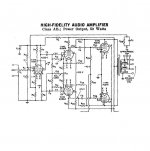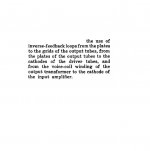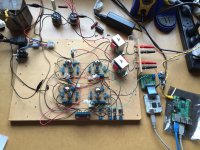As you add stages in an amplifier there is enough phase change between the input and the output so that negative feedback becomes impossible. The feedback becomes in phase and positive so the amp becomes unstable. I've built a few SE amps using Schade, or plate to plate feedback. Is there any reason you couldn't use this feedback in a differential push pull design?
Since the feedback loop is confined between the plates of the voltage amplifier and the output tube the phase difference is, I think, 180 degrees out of phase. But my real question is would this also work in a differential PP design?
Since the feedback loop is confined between the plates of the voltage amplifier and the output tube the phase difference is, I think, 180 degrees out of phase. But my real question is would this also work in a differential PP design?
I've looked at the schematic and there seems to be a mistake in the description of the circuit? It appears to me that there is output tube plate feedback to both the plate and the cathode of 6CB6A. Via r21 to the plate of the 6CB6A and through r22 to the its cathode. I've included the excerpt from the RCA description. Am I missing something here?
What would be the purpose of feedback to both the cathode and plate of 6CB6A?
What would be the purpose of feedback to both the cathode and plate of 6CB6A?
Attachments
Last edited:
I use similar feedback in my Pyramid power amps, from anodes of output Gu-50 tubes to anodes of 6P15P driver tubes that work in a pentode LTP. I would not recommend to surround more than one stage by such a feedback, to avoid harder clipping on overload.
I wasn't thinking of using the global feedback at all. Wavebourn is there any reason to use feedback at both the plate and the cathode?
Hi mr2racer,
It works, listening to one now - a pair of 8CS7 (dual dissimilar triode) per channel, line matching transformer (Altronics M1115) driving near field speakers either side of the monitor. The voltage stage is CCS/LTP, the power stage is CCS/LTP and the VA and PA plates tied.
Also see Baby Huey for an example of feedback.
Scary:
It works, listening to one now - a pair of 8CS7 (dual dissimilar triode) per channel, line matching transformer (Altronics M1115) driving near field speakers either side of the monitor. The voltage stage is CCS/LTP, the power stage is CCS/LTP and the VA and PA plates tied.
Also see Baby Huey for an example of feedback.
Scary:
Attachments
I wasn't thinking of using the global feedback at all. Wavebourn is there any reason to use feedback at both the plate and the cathode?
Yes, to reduce current required by the tube.
As you can see from the schematic diagram, there is no dominant pole compensation. That means, the amp with nested feedbacks is stable. No deep global feedback is needed, but it helps to sweep the rest of dirt under the rug. Find values of resistors for that RCA amp, and you get a very good project. Playing with nested feedbacks I come to similar result in my Pyramid amp, with no need for a HF compensation.
The plate feedback resistor is 330k and the cathode feedback resistor is 100k. Would you use those values even with different tubes? In my case 7591Soutputs and 5751 preamp tubes.
They define feedback ratios, respectively with resistors in anode and cathode.
In my case, I have 12K in anode, and 240K from anode to anode. However, with different tubes everything will be different.
In my case, I have 12K in anode, and 240K from anode to anode. However, with different tubes everything will be different.
On schematic there is also a FB loop with compensation and the values of R-C are related to the load as listed on part list.
In addition there is a local FB on first stage and in the driver stage.
Walter
In addition there is a local FB on first stage and in the driver stage.
Walter
Hello m2racer,
I have been using plate-to-plate (aka. Schade) feedback with good effect in my 6P36S amplifier (http://www.diyaudio.com/forums/tubes-valves/251395-6p36s-push-pull-hifi-amp-4.html).
By experimenting, I found that 100kOhm is just about the right value. I did some measurements purely focused on the effect of it, there is a picture of THD measurements .
In short, it reduced the 3rd order HD around 10 times (from 4% to 0.4%) and increased 2nd order HD around 3 times (from 0.05% to 0.15%) at the same output power level - 60W or so.
The Raa is 4kOhm.
I have been using plate-to-plate (aka. Schade) feedback with good effect in my 6P36S amplifier (http://www.diyaudio.com/forums/tubes-valves/251395-6p36s-push-pull-hifi-amp-4.html).
By experimenting, I found that 100kOhm is just about the right value. I did some measurements purely focused on the effect of it, there is a picture of THD measurements .
In short, it reduced the 3rd order HD around 10 times (from 4% to 0.4%) and increased 2nd order HD around 3 times (from 0.05% to 0.15%) at the same output power level - 60W or so.
The Raa is 4kOhm.
Yes, that is right, the driver is a 6N1P with 27k load and running on 415V. There is the schematic as well.
My own amp is a fully balanced, push-pull plate-to-plate feedback amp. It uses EL34s as output tubes.
Input tubes are a differential pair of EF86 equivalents (Brimar 6BS7) these are direct coupled to a 7044 cathode follower driver, which is cap-coupled to the EL34 control grids. The feedback reaches the control grids of the EL34s via 330K resistors to the plates of the 6BS7s, then passes through the cathode follower drivers.
Being balanced, there is no phase splitter, the amp just takes the balanced output from my DAC as its input. It sounds great.
Input tubes are a differential pair of EF86 equivalents (Brimar 6BS7) these are direct coupled to a 7044 cathode follower driver, which is cap-coupled to the EL34 control grids. The feedback reaches the control grids of the EL34s via 330K resistors to the plates of the 6BS7s, then passes through the cathode follower drivers.
Being balanced, there is no phase splitter, the amp just takes the balanced output from my DAC as its input. It sounds great.
Last edited:
- Status
- Not open for further replies.
- Home
- Amplifiers
- Tubes / Valves
- Schade Feedback In A Push Pull Differential Amplifier?


